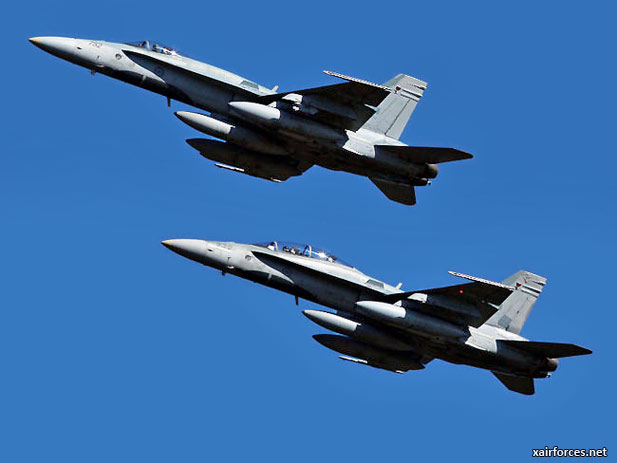
Pilot error on Sunwing flight caused CF-18s to scramble

Pilot error was the reason two Canadian CF-18 Hornet fighter jets scrambled to intercept a Sunwing Airlines flight near Quebec City, after the Toronto-bound aircraft lost contact with air traffic control for more than an hour, a CTV News investigation has learned.
The jets were under the command of NORAD, the military command responsible for the defence of North American airspace.
Until now, little was known about the July 16, 2012, potential air threat. NORAD has maintained that security reasons prevented them from disclosing even the airline involved or how long the aircraft was unresponsive to radio communications.
But secret documents and radio transmissions obtained by CTV News provide a revealing look into how the rare military mission surrounding Sunwing Airlines Flight 221 unfolded over Canadian airspace.
The flight was en route to Toronto Pearson airport from Paris Orly airport with 293 passengers and 10 crew members on board.
CTV News has learned that the plane was owned and operated by Portuguese-based EuroAtlantic Airways, leased to Toronto-based Sunwing Airlines.
Shortly after crossing the Atlantic Ocean and entering Canadian airspace, the plane became unresponsive to communication attempts by NAV Canada air traffic controllers.
Flight records show the Boeing 767-300 had stopped talking to Moncton, N.B., controllers -- last speaking to them at around 12:40 p.m. ET.
After about 45 minutes of silence with ground control, at 1:27 p.m. ET, the military was called in. The internal air defence mission was given the name Operation Noble Eagle, which is NORAD’s response to the Sept. 11, 2001, terrorist attacks.
Two CF-18 armed fighters were then ordered up by NORAD and flew out of 3 Wing at Canadian Forces Base Bagotville, Que.
The scrambled air force jets intercepted the Sunwing airliner north of Riviere-du-Loup, Que., at 1:55 p.m. ET.
“Sunwing 221: this is Vimy 11, an armed air defence fighter,” the air force jets warned the Sunwing plane on the radio frequency reserved for emergency communications for aircraft in distress. “How do you read?”
The Sunwing plane responded immediately to the military’s interception.
The air defence aircraft told the Sunwing pilot that it wasn’t in contact with air traffic controllers. The jets helped the Boeing 767-300 re-establish radio contact with ATC in Montreal at 1:57 p.m. ET
Canadian Forces determined the incident was caused by pilot error. The pilot stopped communicating with the ground because he didn’t complete a required change in the plane’s radio frequency when it flew from one region of airspace to another.
“We’re just wondering now why it was so quiet for some time,” the pilot of the Sunwing plane said over the radio with the CF-18s after the interception, apparently unaware he hadn’t talked to air traffic controllers for more than an hour.
“We just maybe missed a call from Gander to change frequency,” he said.
Retired Lt.-Gen. Ken Pennie, former deputy commander-in-chief of NORAD and chief of the air staff, said it was “unusual” for the pilot not to speak with air traffic controllers for so long.
“I would have thought he would have twigged before an hour went by,” Pennie said.
“Normally it doesn’t take that length to change a frequency on an airplane, and sometimes aircraft captains will miss changing frequencies,” he added. “Changing frequencies is not that hard, and so that allows me to think that maybe something was going on in that aircraft; they’re distracted, but not dangerously so.”
Pennie, who was with NORAD during the terrorist attacks on the World Trade Centre, stressed passengers “were never in danger,” but understood why fighter jets were dispatched.
“I think we can all recognize that after 9-11, we treat these things a little bit more carefully than we did previously,” he said.
“When you’re silent for that period of time, obviously air traffic control authority in that case probably felt there was something worth passing to NORAD.”
Department of National Defence figures say the total cost per flying hour for the CF-18 Hornets is $44,493. The mission involving the two jets lasted just over an hour, costing taxpayers about $90,000.
Sunwing Airlines president Mark Williams dismissed the loss of radio contact as a “minor incident” that “wasn’t a safety risk of any kind.”
“It doesn’t happen regularly -- certainly not something that anyone wants to happen,” he said. “I mean, it’s not the first time that’s happened and likely won’t be the last.
“It’s something that happens in the middle of a flight – certainly not a safety issue as far as I’m concerned -- and once radio contact was established the plane landed safely in Toronto.”
The CF-18s continued to travel alongside the Sunwing aircraft for 23 minutes, before returning to base at 2:21 p.m. ET when it was determined the flight no longer required military assistance. Sunwing Airlines Flight 221 continued on its flight plan to Toronto, where it landed 33 minutes later.
Portugal’s EuroAtlantic Airways, which operated the plane for Sunwing, did an internal review of its pilots’ procedures and the cause of the radio silence, according to Williams.
“It’s up to (EuroAtlantic) to put the corrective actions into place,” he said. “We wanted to make sure we were comfortable with the investigation and ultimately with the outcome, and we were.”
Source: Ottawa Bureau Chief Robert Fife and field producer Philip Ling, CTV News - 26 February 2013
Photo: The Royal Canadian Air Force CF-18 Fighter Aircraft (Photo by storage.canoe.ca)
(26.02.2013)
|